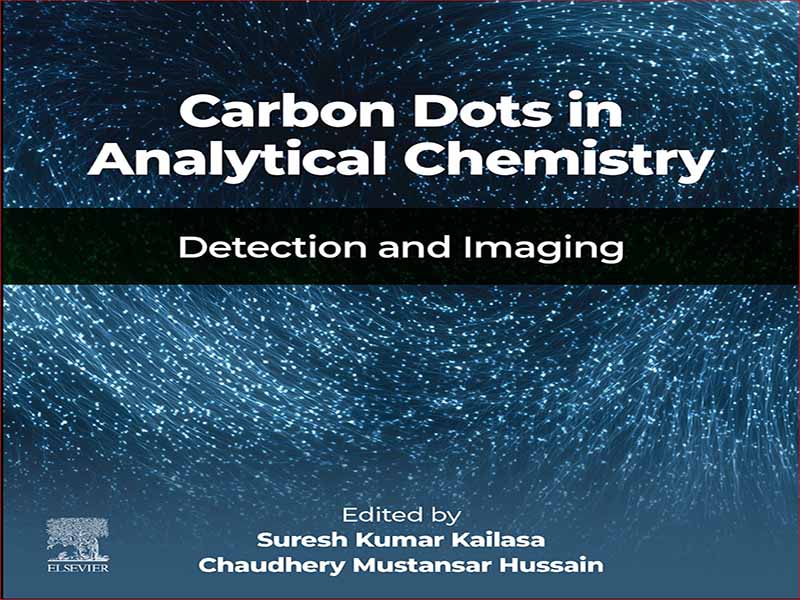- عنوان کتاب: Carbon Dots in Analytical Chemistry
- نویسنده: Suresh-Kumar-Kailasa
- حوزه: کربن
- سال انتشار: 2023
- تعداد صفحه: 366
- زبان اصلی: انگلیسی
- نوع فایل: pdf
- حجم فایل: 11.5 مگابایت
نقاط کربنی کلاس جدیدی از مواد نانوساختار کربنی چندرنگی قابل پخش در آب با کاربردهای برجسته در حوزه تحقیقاتی چند رشتهای هستند. کاربردهای تحلیلی نقاط کربن در چند سال اخیر به سرعت در رشته های مختلف از جمله علوم زیست محیطی، دارویی، پزشکی قانونی، مواد غذایی و زیست پزشکی گسترش یافته است. این یک کتاب بسیار به موقع است که هم برای کسانی که در شیمی مواد و شیمی تجزیه کار می کنند و هم برای کسانی که وارد این زمینه می شوند، یک کتاب ارزشمند است. رویکرد سازمانی ما در این کتاب برگرفته از رویکردهای مصنوعی، ویژگیها، خصوصیات و کاربردهای تحلیلی نقاط کربن است. چالش ما ارائه یک توصیف جامع در مورد مسیرهای مصنوعی (از بالا به پایین و پایین به بالا) و ابزارهای تحلیلی برای توصیف نقاط کربن و ادغام آنها با طیف گسترده ای از تکنیک های تحلیلی برای توسعه استراتژی های تحلیلی سبز برای سنجش بوده است. سطح کمیاب گونه های شیمیایی و تصویربرداری از سلول ها. هدف اصلی این کتاب گزارش مطالعات جدید نقاط کربن در فناوریهای تحلیلی برای سنجش مولکولی و تصویربرداری سلولی است. علاوه بر این، برای پرداختن به تاکید روزافزون در علوم نانوتحلیلی به ادغام نقاط کربن با تکنیکهای تحلیلی مختلف، و ایجاد آگاهی در مورد شیمی تحلیلی نقاط کربن، کتاب را در 26 فصل تنظیم کردیم که توصیفی جامع در مورد چهار جنبه از نقاط کربن شامل نقاط مختلف ارائه میکند. روشهای مصنوعی برای تهیه نقاط کربن، خواص نقاط کربن، تکنیکهای تحلیلی برای توصیف نقاط کربن، و ادغام آنها با تکنیکهای تحلیلی مختلف برای سنجش آنالیتهای سطح ردیابی (غیر آلی، آلی، بیومولکولها و مواد منفجره) و تصویربرداری از سلولها. متن با مفاهیم اصلی در مسیرهای بالا به پایین (تخلیه قوس، فرسایش لیزری، اچینگ الکتروشیمیایی، اکسیداسیون شیمیایی و روشهای آسیاب گلولهای) و از پایین به بالا (هیدروترمال، حلالگرمایی، تجزیه در اثر حرارت، کربنسازی و مایکروویو) برای آمادهسازی نقاط کربن با ویژگیهای خاص آغاز میشود. خواص نوری و شیمی سطح، که مفهومی اساسی در توسعه استراتژیهای تحلیلی مبتنی بر نقاط کربن است. در فصل های مربوط به خواص و خصوصیات نقاط کربن، خواص نوری (جذب، فسفرسانس، نورتابی نور، لومینسانس شیمیایی و الکتروشیمیایی، و لومینسانس رو به تبدیل) و فیزیکوشیمیایی (بازده کوانتومی، بلورینگی، پایداری نور، سمیت سلولی) و خواص کاتالیستی هستند. شرح داده شده. کاربردهای بالقوه نقاط کربن در آماده سازی نمونه (استخراج فاز جامد، استخراج فاز جامد پراکنده، میکرو استخراج مغناطیسی فاز جامد) و علم جداسازی به خوبی مورد بحث قرار گرفته است. کاربردهای تحلیلی نقاط کربن در مجموعه ای از 20 فصل با تاکید بر ادغام نقاط کربن با تکنیک های تحلیلی مختلف برای سنجش مولکول و مطالعات تصویربرداری سلولی معرفی شده است. این فصلها پیشرفتهای اخیر ابزارهای الکتروتحلیلی مبتنی بر نقاط کربن را برای تشخیص مولکولهای هدف مختلف ارائه میکنند. مشارکت کنندگان سهم قابل توجهی در بحث نقاط کربن در تکنیک های طیف سنجی (UV_visible، فلورسانس، و MALDI-MS) برای تشخیص آنالیت های سطح ردیابی و تکنیک های میکروسکوپی فلورسانس برای تصویربرداری از سلول های مختلف داشته اند. فصلهای بعدی همچنین کاربرد نقاط کربن را در علم پزشکی قانونی، کیفیت مواد غذایی، علوم کشاورزی، تصفیه فاضلاب و کاتالیز توصیف میکنند. در سراسر کتاب مفاهیم اساسی و رویکردهای مکانیکی نقاط کربن در شیمی تجزیه را با اشاره به مشکلات موجود در آمادهسازی نمونه، علوم جداسازی، محیطزیست، پزشکی قانونی، کشاورزی، و علوم زیست پزشکی نشان دادهایم. مشارکت کنندگان تجربه قابل توجهی در کاربرد نقاط کربن در شیمی تحلیلی دارند و در مطالعه رویکردهای تحلیلی مبتنی بر نقاط کربن برای شناسایی مولکول های مختلف و تصویربرداری از سلول ها پیشگام بوده اند.
Carbon dots are a new class of water dispersible multicolor emissive carbon nanostructure materials with outstanding applications in multidisciplinary research area. Analytical applications of carbon dots have rapidly expanded into various disciplines including environmental, pharmaceutical, forensic, food, and biomedical sciences in the last few years. This is a very timely book that will prove to be a valuable one both for those working in materials chemistry and analytical chemistry and for those entering in this field. The organizational approach we take in this book builds from the synthetic approaches, properties, characterization, and analytical applications of carbon dots. Our challenge has been to provide a comprehensive description on synthetic routes (top-down and bottom-up) and analytical tools for the characterization of carbon dots, and their integration with a wide variety of analytical techniques for the development of green analytical strategies for sensing of trace level chemical species and imaging of cells. The main object of this book is to report on new studies of carbon dots in analytical technologies for molecular sensing and cell imaging. Further, to address the increasing emphasis in nanoanalytical sciences to integrating carbon dots with various analytical techniques, and creation of awareness on analytical chemistry of carbon dots, we organized the book into 26 chapters that provide a comprehensive description on four aspects of carbon dots including different synthetic approaches for the preparation of carbon dots, properties of carbon dots, analytical techniques for the characterization of carbon dots, and their integration with different analytical techniques for sensing trace level analytes (inorganic, organic, biomolecules, and explosives) and imaging of cells. The text begins with core concepts on the topdown (arc discharge, laser ablation, electrochemical etching, chemical oxidation and ball milling methods) and bottom-up (hydrothermal, solvothermal, pyrolysis, carbonization, and microwave) routes for preparation of carbon dots with specific optical properties and surface chemistry, which is fundamental concept in the development of carbon dots-based analytical strategies. In the chapters dealing with properties and characterization of carbon dots, optical properties (absorption, phosphorescence, photoluminescence, chemi- and electrochemical-luminescence, and upconversion luminescence) and physicochemical (quantum yield, crystallinity, photostability, cytotoxicity, and catalytic) properties are well described. Potential applications of carbon dots in sample preparations (solid-phase extraction, dispersive solid-phase extraction, magnetic solid-phase microextraction) and separation science are well discussed. Analytical applications of carbon dots are introduced in a series of 20 chapters with an emphasis on the integration of carbon dots with various analytical techniques for molecule sensing and cell imaging studies. These chapters provide recent advances of carbon dots-based electroanalytical tools for the detection of various target molecules. Contributors have made significant contribution in discussing the carbon dots in spectroscopic (UV_visible, fluorescence, and MALDI-MS) techniques for recognition of trace level analytes and fluorescence microscopic techniques for imaging of various cells. The subsequent chapters also describe the applications of carbon dots in forensic science, food quality, agriculture science, wastewater treatment and catalysis. Throughout the book we have illustrated the fundamental concepts and mechanistic approaches of carbon dots in analytical chemistry referring to the problems in sample preparation, separation science, environmental, forensic, agriculture, and biomedical sciences. The contributors have considerable experience in carbon dots applications in analytical chemistry and have pioneered the study of carbon dots-based analytical approaches for recognition of various molecules and imaging of cells.
این کتاب را میتوانید از لینک زیر بصورت رایگان دانلود کنید:
Download: Carbon Dots in Analytical Chemistry




































نظرات کاربران